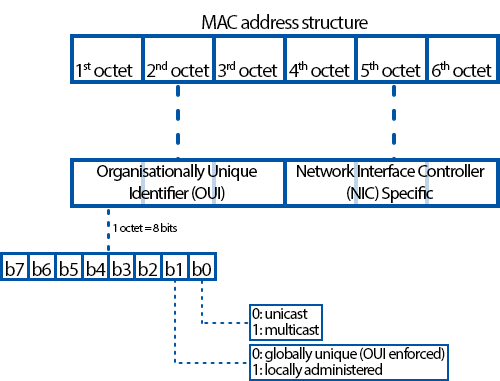Template:Networking device nomenclature mac address: Difference between revisions
Appearance
No edit summary |
No edit summary |
||
| Line 20: | Line 20: | ||
<tr> | <tr> | ||
<td>Teltonika</td> | <td>Teltonika</td> | ||
<td> | <td>20:97:27</td> | ||
<td> | <td>20:97:27: <b>[00:00:00</b> - <b>FF:FF:FF]</b></td> | ||
</tr> | </tr> | ||
</table> | </table> | ||
Revision as of 13:17, 2 March 2023
A media access control (MAC) address is a unique identifier assigned to network interfaces for communications at the data link layer of a network segment. MAC addresses are used as a network address for most IEEE 802 network technologies, including Ethernet and WiFi.
MAC address structure
A MAC address is comprised of six octets or in other words, six 8 bit long segments. The first three octets make up the Organisationally Unique Identifier (OUI), i.e., it can be used to identify the device's manufacturer. Refer to the figure below for a visual representation:
Teltonika OUI
The following MAC addresses belong to Teltonika:
| Vendor | MAC prefix (OUI) | Possible MAC addresses |
|---|---|---|
| Teltonika | 20:97:27 | 20:97:27: [00:00:00 - FF:FF:FF] |
External links
- MAC address vendor search: https://regauth.standards.ieee.org/standards-ra-web/pub/view.html#registries
- Some information was taken and modified from Wikipedia: https://en.wikipedia.org/wiki/MAC_address
[[Category:{{{name}}} Nomenclature, classification codes]]

